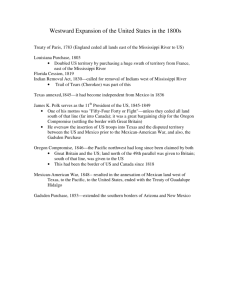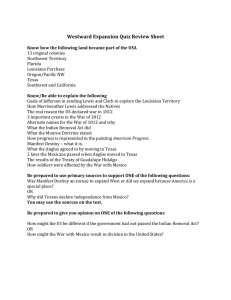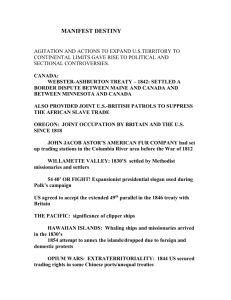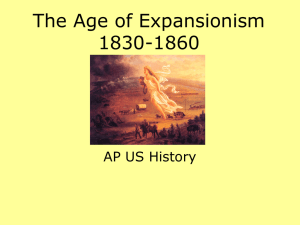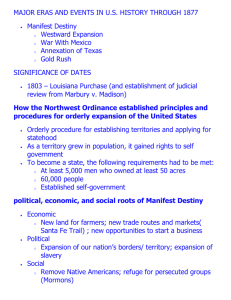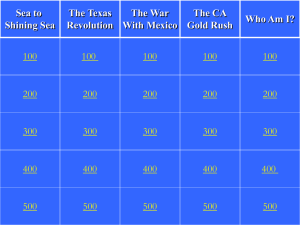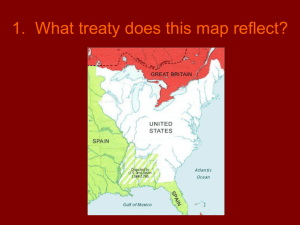Warof1812
advertisement
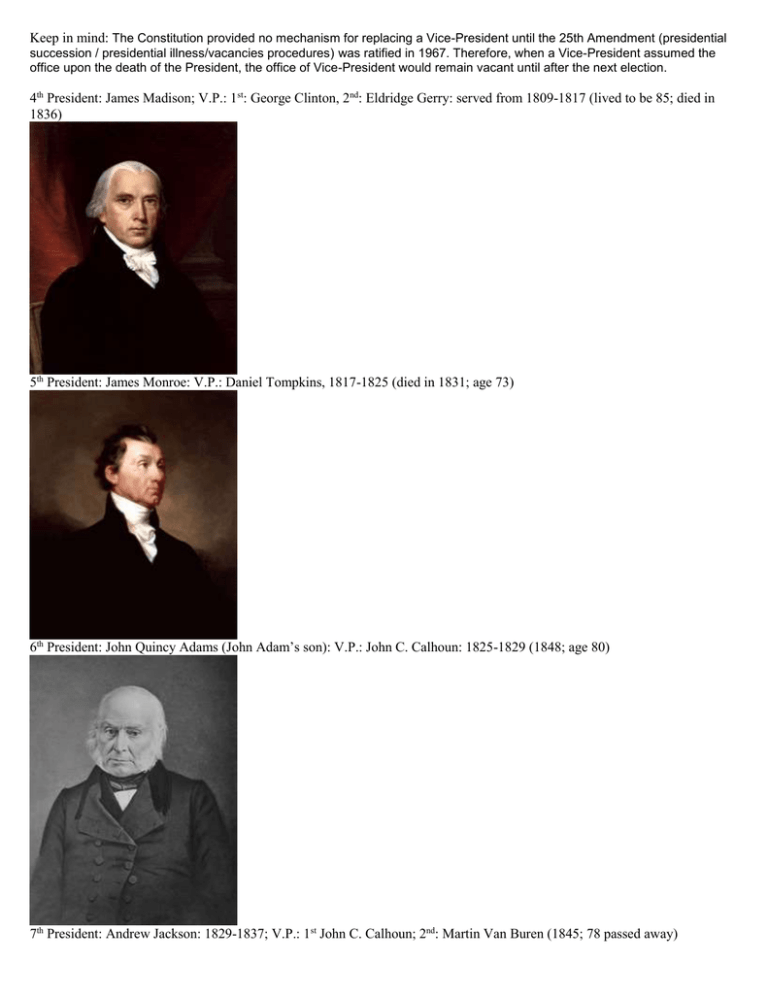
Keep in mind: The Constitution provided no mechanism for replacing a Vice-President until the 25th Amendment (presidential succession / presidential illness/vacancies procedures) was ratified in 1967. Therefore, when a Vice-President assumed the office upon the death of the President, the office of Vice-President would remain vacant until after the next election. 4th President: James Madison; V.P.: 1st: George Clinton, 2nd: Eldridge Gerry: served from 1809-1817 (lived to be 85; died in 1836) 5th President: James Monroe: V.P.: Daniel Tompkins, 1817-1825 (died in 1831; age 73) 6th President: John Quincy Adams (John Adam’s son): V.P.: John C. Calhoun: 1825-1829 (1848; age 80) 7th President: Andrew Jackson: 1829-1837; V.P.: 1st John C. Calhoun; 2nd: Martin Van Buren (1845; 78 passed away) 8th President: Martin Van Buren: 1837-1841; V.P.: Richard Mentor Johnson (1862; age 79 passed away) 9th President: William Henry Harrison: V.P.: John Tyler; March 1841- April 1841 (died of pneumonia; shortest presidential term served; age 68) 10th President: John Tyler: 1841-1845; No V.P. because of not being elected and the circumstances that occurred (died 1862; age 71) 11th President: James K. Polk: 1845-1849; V.P.: George M. Dallas (died 1849 two months after serving his first term; age 53) 12th President: Zachary Taylor: 1849-1850; V.P.: Millard Fillmore (died in 1850; age 65) 13th President: Millard Fillmore: 1850-1853; No V.P. (died in 1874; age 74) 14th President: Franklin Pierce: 1853-1857: V.P.: William King died of illness (served six weeks) then none (died 1869; age 64) War of 1812: Known as the Second War of Independence Americans versus the British. British wanted to restrict U.S. trade, The Royal Navy’s impressment of American seamen (like in the War of Tripoli) America wanted to expand its territory. British support of Native Americans against U.S. expansion The war was fought in three regions: the Atlantic Coast, the Great Lakes and Canada, and the Southern United States. August 1814: Because the Americans lost the Battle of Bladensburg, Washington D.C.’s White House and the Capitol were burned down. American troops were able to resist British invasions in New York, Baltimore, and New Orleans. 1809: Thomas Jefferson’s Embargo Act was repealed and replaced with the Non-Intercourse Act (don’t trade with the French or British). 1810: Napoleon hints that he would stop trade restrictions, so President James Madison blocked all trade with just the British. Congress: wanted war against the British for violations of maritime rights and for getting Native Americans to hate on them for expanding West. Neither side was prepared for war, which continued for two and a half years as a stalemate (unresolved tensions, no one wins). The two countries signed the Treaty of Ghent in December of 1814 to end the war, although slow communication allowed fighting to continue for a few months after the Treaty was signed. The ratification of the Treaty of Ghent in 1815 ended the war. Many viewed the war as a second, more definitive, assertion of American independence. The war's conclusion is said to have ushered in an "Era of Good Feelings," a period of American political unity that took place during the presidencies of James Madison and James Monroe. Convention of 1818 The Convention of 1818 set the boundary between the Missouri Territory in the United States and British North America (later Canada). The Convention respecting fisheries, boundary and the restoration of slaves between the United States of America and the United Kingdom of Great Britain and Ireland, was an international treaty signed in 1818 between the United States and the United Kingdom. Signed during the presidency of James Monroe, it resolved standing boundary issues between the two nations. The treaty allowed for joint occupation and settlement of the Oregon Country. Adams-Onis Treaty The Adams-Onis Treaty between the United States and Spain concluded all controversies regarding Spain's claims to Florida. Signed in Washington DC on February 22, 1819, by John Quincy Adams, the American secretary of state, and Luis de Onis, the Spanish minister, the treaty had three main effects. All Spanish claims to East Florida were abandoned and the territory ceded to the United States, The de facto control of West Florida, which had been in American hands since Andrew Jackson had established the American presence in 1818, was recognized, and a firm delineation of the border between the Louisiana Purchase and the remaining Spanish claims in North America was settled, beginning with the Sabine River between Texas and Louisiana. The United States assumed the claims of its citizens against Spain, up to $5 million, and Pinckney's Treaty of 1795 was continued to the extent that it did not conflict. The Spanish were not pleased with the treaty and delayed ratification while hoping to gain support from fellow European powers. None was forthcoming and after King Ferdinand was reduced to a constitutional monarch in 1820, Spain approved the treaty. Missouri Compromise Missouri Compromise of 1820, tensions began to rise between pro-slavery and anti-slavery factions within the U.S. Congress and across the country. They reached a boiling point after Missouri’s 1819 request for admission to the Union as a slave state, which threatened to upset the delicate balance between slave states and free states. To keep the peace, Congress orchestrated a two-part compromise, granting Missouri’s request but also admitting Maine as a free state. It also passed an amendment that drew an imaginary line across the former Louisiana Territory, establishing a boundary between free and slave regions that remained the law of the land until it was negated by the Kansas-Nebraska Act of 1854. Monroe Doctrine In December 1823, President James Monroe addressed Congress with a new policy to solidify the split between the Americas and imperial Europe. Known as the Monroe Doctrine, this policy has had a long-lasting effect on American foreign policy. It follows President Washington's farewell advice to keep American affairs separate from European affairs: "The great rule of conduct for us in regard to foreign nations is in extending our commercial relations, to have with them as little political connection as possible" The Doctrine contains three main ideas: Separate spheres of influence for the Americas and Europe, non-colonization, and non-intervention. The Monroe Doctrine declared that the Americas could no longer be subject to colonization by European powers, providing precedent and support for U.S. expansion on the American continent. As such, the Monroe Doctrine sent a strong message to European powers. It represented a symbol of American nationalism and it set the stage for the United States to expand west and to have a strong presence in Latin America as well. Trail of Tears Trail of Tears Map In May 1830 President Jackson signed the Indian Removal Act into law. The act gave the president the right to negotiate treaties with American Indians, under which Indians were to give up their land within American boundaries in exchange for land west of the Mississippi. In theory, the relocation was to be voluntary and peaceable. While this was true for some, most tribes were coerced into signing removal treaties against their will. Still others were forcibly removed without signing a treaty. The Indian nations of the Southeast resisted relocation. The Choctaw, Seminole, Creek and Chickasaw nations each made some form of agreement with the Jackson administration that would ostensibly either protect their holding east of the Mississippi or guarantee a good deal west of the Mississippi. The Jackson administration, however, betrayed each of these arrangements in one way or another. The last of the five southeast nations, the Cherokee, faced perhaps the worst fate. In 1833, a few members of the Cherokee nation who were not authorized to negotiate treaties signed the Treaty of New Echota, which the Supreme Court ratified against the will of the Cherokee. After the majority of the Cherokee refused to relocate voluntarily, the United States government sent 7,000 troops into Cherokee territory to force the remaining 16,000 westward. Along the way, 4,000 Cherokee people died while countless others suffered from illness, cold and hunger. This removal process became known as the Trail of Tears because of its devastating effects on the Cherokee nation. Texas Annexation The annexation of Texas happened in 1836 when they declared independence from Mexico. The Mexicans threatened to wage war against America if Texas became independent. President James K. Polk signed Texas as the 28th state in 1845. Because of this, the Mexican-American war started. In 1836, Texas declared independence from Mexico, becoming its own independent republic including parts of presentday Colorado, New Mexico, Wyoming, Kansas, and Oklahoma. In Texas' first election as an independent republic, Texans voted in favor of annexation to the United States. However, no treaty of annexation was ratified by both Texas and the United States until 1845. In March of that year, Congress passed the Joint Resolution for the Annexation of Texas to the United States. Popularly-elected representatives from Texas voted to accept the resolution, and submitted the Ordinance of Annexation to Congress. In turn, Congress accepted Texas' terms and issued the Joint Resolution for the Admission of the State of Texas into the Union. President James K. Polk signed Texas as the 28th state in December of 1845. There was much controversy over the admission of Texas as a state. Many questioned the legality of admitting a state by resolution rather than the traditional method of annexation by treaty. It was later determined that annexation by resolution is legal. In addition, there was plenty of opposition to the annexation of Texas. Many in the North believed that adding Texas as a state would throw off the balance between slave and non-slave states and push the U.S. toward civil war. Mexico, too, opposed the annexation, as they still believed Texas to be Mexican territory. Mexico warned the United States that the annexation of Texas would likely lead to war, a prophecy that was fulfilled by the MexicanAmerican War. Manifest Destiny o o The painting (American Progress or "Spirit of the Frontier”) is an allegory of Manifest Destiny. An allegory is a visible symbol representing an abstract idea. The Manifest Destiny painting conveys the idea of American Progress and Westward expansion using progressive transportation system with people heading westwards who are guided and protected by the quasi-mythical goddess Columbia, as symbol of America. Columbia also represents Progress and Destiny, guiding the nation through a course of events that will inevitably happen in the future. Columbia holds the book of knowledge and enlightenment and also the wires of the telegraph enabling communication across the vast nation. The Manifest Destiny Painting conveys the history of the past, the innovations of the present and a vision of the future. Perhaps no concept shaped American identity stronger than Manifest Destiny. Newspaper editor John O'Sullivan coined the term in 1845 to promote the Annexation of Texas, and it stuck as a rallying cry for American expansion. o Americans used the concept of Manifest Destiny to justify their aggressive westward expansion, claiming that it was God's will for them to expand and that their aim was the spread of liberty and democracy. o To summarize: The phrase encompassed the idea that Westward Expansion, and occupation the North American continent, was a divine right of the American people. It was based on the belief of cultural and racial superiority over other nations and the obligation to bring civilization and enlightenment to other races. The phrase "Manifest Destiny" was coined by the journalist John O'Sullivan in 1845. The phrase "Manifest Destiny" is most frequently associated with the massive territorial expansion of the United States over just fifty years from 1803 to 1853 and its westward expansion to the Pacific Ocean. Oregon Territory o In 1846, Congress approved the Oregon Treaty, which established the boundary between Canada and the United States at the 49th parallel and ceded the Oregon Territory to the US from Britain. The 286,000 square miles of land includes the present-day states of Oregon, Washington, Idaho and portions of Montana and Wyoming. o The British government did not want another war with the United States, and the U.S. was anticipating war with Mexico on the horizon. Thus, both sides were eager to come to an agreement. The treaty was a great success for President James K. Polk, as it gained land for the United States without entering into a conflict or a long, drawn-out process. Mexican American War/Mexican Cession o After its independence in 1821 and brief experiment with monarchy, Mexico became a republic in 1824, characterized by considerable instability, so that when the U.S. initiated the conflict with the Centralist Republic of Mexico, Mexico was ill-prepared to respond. The war with the U.S. followed in the wake of decades of Indian raids in the north of Mexico, which Anglo-American migration to the Mexican province of Texas was aimed at buffering. Anglo-Americans and some Mexicans revolted against the Mexican government in the 1836 Texas Revolution, creating a republic not recognized by Mexico, which still claimed it as its national territory. The 1845 expansion of U.S. territory with its annexation of Texas escalated the dispute between the U.S. and Mexico into open war. o U.S. forces quickly occupied Santa Fe de Nuevo México and Alta California Territory, then invaded parts of Northeastern Mexico and Northwest Mexico; meanwhile, the Pacific Squadron conducted a blockade, and took control of several garrisons on the Pacific coast farther south in Baja California Territory. Another U.S. army, under General Winfield Scott captured the capital Mexico City, marching from the port of Veracruz, virtually unopposed. o The war ended in a victory for the United States. During this period, the leadership of the Mexican Army changed frequently. Political factionalism was intensely divisive and led at one point to open civil war in the capital. As a result of America’s victory of the Mexican War resulting in the annexation of the territory now known as California, Nevada, New Mexico, Colorado, Utah and most of Arizona. Jefferson Davis was a Mexican War hero and served in the House of Representatives and the Senate, but he is nest known as the president of the Confederacy during the American Civil War. The Papers of Jefferson Davis is a documentary editing project started at Rice University in Houston, Texas. The site contains Davis's letters, speeches, genealogy, and numerous images. o o California Gold Rush On January 24, 1848 James Marshall and Peter L. Wimmer discovered gold at Sutter's new sawmill on the American River, setting in motion the California Gold Rush. Sam Brannan printed a page in the California Star detailing the gold mines in the Sacramento valley attempting to encourage immigration. News spread rapidly of the gold found in California. People came from as far as China. People were mining as much as $50,000 a day. Mexican migrants, Chilean migrants, Australian migrants, and foreigners from Mexico, Chile and even Australian came to seek their fortune in gold. At this time, the population of California was estimated at 100,000 including 35,000 people who came by sea, 3000 sailors who deserted ships and 42,000 who came overland. There were some 40,000 people mining in California by the end of 1849. Compromise of 1850 Another stopgap measure along the lines of the Missouri Compromise. This one abolished the slave trade in the District of Columbia but bound Congress to create became the Fugitive Slave Law. The Fugitive Slave law is due to heightened Northern fears of a "slave power conspiracy". It required that all escaped slaves were, upon capture, to be returned to their masters and that officials and citizens of free states had to cooperate in this law. Abolitionists nicknamed it the "Bloodhound Law" for the dogs that were used to track down runaway slaves. The Compromise of 1850 also admitted California as a free state and separately organized the territories of Utah and New Mexico without restrictions on slavery. Kansas-Nebraska Act In 1854, Congress passed the Kansas-Nebraska Act, which organized the remaining territory acquired in the Louisiana Purchase so that such territories could be admitted to the Union as states. Probably the most important result of the Kansas-Nebraska Act was its language concerning the contentious issue of slavery. Proposed by Stephen A. Douglas, and signed by President Franklin Pierce, the bill divided the region into two territories. Territory north of the 40th parallel was called Nebraska Territory, and territory south of the 40th parallel was called Kansas Territory. The most controversial aspect of the Kansas-Nebraska Act was that each territory would decide for itself whether or not to permit slavery. This stipulation repealed the Missouri Compromise of 1820 which stated that slavery was prohibited north of 36° 30′. As there was more support for slavery in Kansas, both pro-slavery and anti-slavery advocates organized teams of people to settle in the state. Not surprisingly, the area became a battleground for both sides, and the resulting violence caused the territory to be referred to as “Bleeding Kansas,” and was one of the first major causes of the Civil War. Eventually, on January 29, 1861, after much controversy, Kansas was admitted to the Union as a free state – just months before the first shots of the Civil War were fired. To summarize: 1854 Act of Congress that repealed the Missouri Compromise and introduced as the guiding principle behind the incorporation of the Kansas and Nebraska Territories the idea of popular sovereignty--the idea that citizens of newly formed territories could decide when they applied for statehood whether slavery would be allowed in their new state. Lincoln drew distinct differences between the idea of popular sovereignty and the Dred Scott Decision. Dred Scott Decision: Affirming the right of slave owners to take their slaves into the Western territories. Gadsden Purchase On December 30 1853, the Gadsden Purchase added a small part of Mexico to New Mexico Territory. On May 30 1854, Nebraska Territory and Kansas Territory was organized; the remaining portion of unorganized territory became known colloquially as "Indian territory". Gadsden met with Santa Anna on September 25, 1853. President Pierce sent verbal instructions for Gadsden through Christopher Ward, an agent for U.S. investors in the Garay project, giving Gadsden negotiating options ranging from $50 million for lower California and a large portion of northern Mexico to $15 million for a smaller land deal. Santa Anna refused to sell a large portion of Mexico. But Santa Anna needed money to fund an army, on December 30, 1953 he and Gadsden signed a treaty stipulating that the United States would pay $15 million for 45,000 square miles south of the New Mexico territory and assume private American claims, including those related to the Garay deal. The United States Government agreed to work toward preventing American raids along Mexico’s border and Mexico voided U.S. responsibility for Native American attacks. With a great deal of difficulty resulting from the increasing strife between the northern and southern states, the U.S. Senate ratified a revised treaty on April 25, 1854. The new treaty reduced the amount paid to Mexico to $10 million and the land purchased to 29,670 square miles, and removed any mention of Native American attacks and private claims. President Pierce signed the treaty and Gadsden presented the new treaty to Santa Anna, who signed it on June 8, 1854. After Gadsden’s Purchase a new border dispute caused tension over the United States’ payment, and the treaty failed to resolve the issues surrounding financial claims and border attacks. However, it did create the southern border of the present-day United States, despite the beliefs of the vast majority of policymakers at the time who thought the United States would eventually expand further into Mexico.

